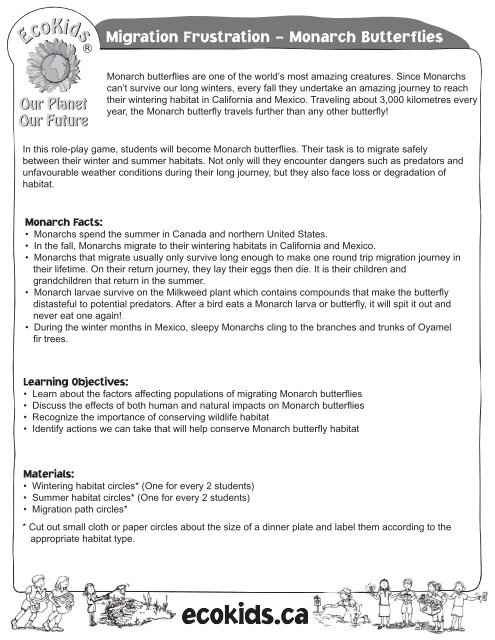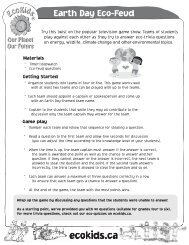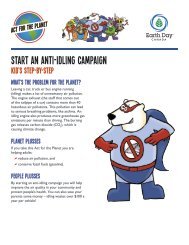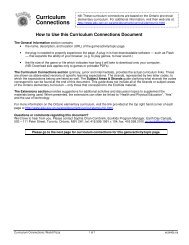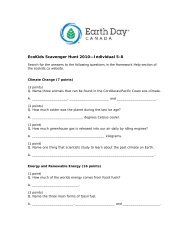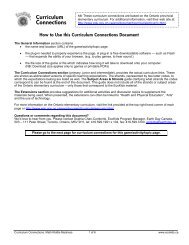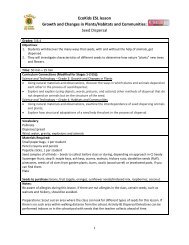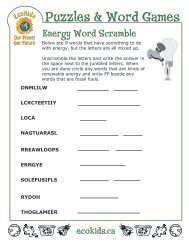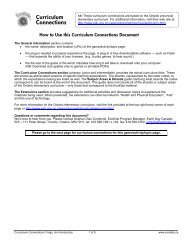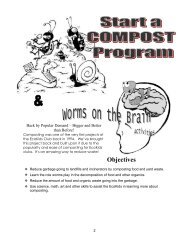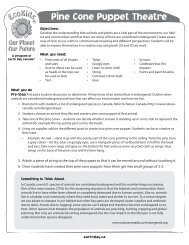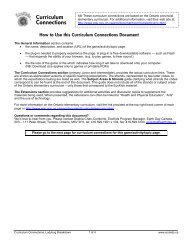Migration Frustration â Monarch Butterflies - EcoKids
Migration Frustration â Monarch Butterflies - EcoKids
Migration Frustration â Monarch Butterflies - EcoKids
You also want an ePaper? Increase the reach of your titles
YUMPU automatically turns print PDFs into web optimized ePapers that Google loves.
<strong>Migration</strong> <strong>Frustration</strong> – <strong>Monarch</strong> <strong>Butterflies</strong><br />
<strong>Monarch</strong> butterflies are one of the world’s most amazing creatures. Since <strong>Monarch</strong>s<br />
can’t survive our long winters, every fall they undertake an amazing journey to reach<br />
their wintering habitat in California and Mexico. Traveling about 3,000 kilometres every<br />
year, the <strong>Monarch</strong> butterfly travels further than any other butterfly!<br />
In this role-play game, students will become <strong>Monarch</strong> butterflies. Their task is to migrate safely<br />
between their winter and summer habitats. Not only will they encounter dangers such as predators and<br />
unfavourable weather conditions during their long journey, but they also face loss or degradation of<br />
habitat.<br />
<strong>Monarch</strong> Facts:<br />
• <strong>Monarch</strong>s spend the summer in Canada and northern United States.<br />
• In the fall, <strong>Monarch</strong>s migrate to their wintering habitats in California and Mexico.<br />
• <strong>Monarch</strong>s that migrate usually only survive long enough to make one round trip migration journey in<br />
their lifetime. On their return journey, they lay their eggs then die. It is their children and<br />
grandchildren that return in the summer.<br />
• <strong>Monarch</strong> larvae survive on the Milkweed plant which contains compounds that make the butterfly<br />
distasteful to potential predators. After a bird eats a <strong>Monarch</strong> larva or butterfly, it will spit it out and<br />
never eat one again!<br />
• During the winter months in Mexico, sleepy <strong>Monarch</strong>s cling to the branches and trunks of Oyamel<br />
fir trees.<br />
Learning Objectives:<br />
• Learn about the factors affecting populations of migrating <strong>Monarch</strong> butterflies<br />
• Discuss the effects of both human and natural impacts on <strong>Monarch</strong> butterflies<br />
• Recognize the importance of conserving wildlife habitat<br />
• Identify actions we can take that will help conserve <strong>Monarch</strong> butterfly habitat<br />
Materials:<br />
• Wintering habitat circles* (One for every 2 students)<br />
• Summer habitat circles* (One for every 2 students)<br />
• <strong>Migration</strong> path circles*<br />
* Cut out small cloth or paper circles about the size of a dinner plate and label them according to the<br />
appropriate habitat type.
<strong>Migration</strong> <strong>Frustration</strong> – <strong>Monarch</strong> <strong>Butterflies</strong><br />
1. In a spacious classroom, gym or outdoor area, set up 2 habitat areas approximately<br />
15 feet apart. Lay the winter habitat circles at one end of your playing area and the<br />
summer habitat circles at the other end. In the corridor between the two areas,<br />
place the migration path circles.<br />
W<br />
S<br />
W<br />
S<br />
W<br />
S<br />
W<br />
S<br />
W<br />
S<br />
2. Students begin in their summer habitat. Instruct each student to place a foot on a habitat circle.<br />
Only two <strong>Monarch</strong>s may occupy one habitat circle at a time.<br />
3. Explain that the <strong>Monarch</strong>s have spent the summer laying eggs and gathering energy for their<br />
journey. It’s fall and the weather is getting colder; it’s time to migrate south!<br />
4. As they move from their summer to winter habitat, explain that they must follow the migratory path by<br />
stepping onto the migration path circles. When they get to their winter habitat, remind them that only<br />
two students can occupy one habitat circle at a time. Encourage students to flap their “wings” like<br />
real butterflies as they make their journey south.<br />
5. Round One - The first round should go smoothly as there has been no habitat destruction and all<br />
“butterflies” should have successfully migrated to suitable winter habitat.<br />
6. Round Two - Before the <strong>Monarch</strong>s migrate back to their summer habitat, read scenario #1 and take<br />
away the corresponding number of summer habitat circles. Instruct the <strong>Monarch</strong>s to begin<br />
migrating. Since some winter habitat has been lost, some <strong>Monarch</strong>s will “die” and must move to the<br />
sidelines.<br />
7. Round Three – Some <strong>Monarch</strong>s have died because of loss of habitat (the “dead” <strong>Monarch</strong>s will<br />
have a chance to return to the game). Before the <strong>Monarch</strong>s migrate to their winter habitat, read<br />
scenario #2 and take away the corresponding number of winter habitat circles.
<strong>Migration</strong> <strong>Frustration</strong> – <strong>Monarch</strong> <strong>Butterflies</strong><br />
8. Round Four – More <strong>Monarch</strong>s have died due to loss of habitat. Read scenario #3<br />
before instructing the <strong>Monarch</strong>s to migrate and replace the corresponding number<br />
of summer habitat. Instruct the “dead” <strong>Monarch</strong>s to rejoin the game.<br />
9. Repeat the migration journey a few more times to illustrate how <strong>Monarch</strong><br />
populations fluctuate<br />
Scenarios (you may adjust the number of habitat circles you are adding and taking<br />
away based on the number of students playing):<br />
1. Summer habitat: Construction of a freeway has caused the clearing of large fields where native wild<br />
flowers and Milkweed used to grow. Remove 2 habitat circles.<br />
2. Winter habitat: Illegal logging of the Oyamel fir forest occurs. Remove 3 habitat circles.<br />
3. Summer habitat: <strong>EcoKids</strong> clubs across Canada have been planting native butterfly gardens.<br />
Reintroduce 2 habitat circles.<br />
4. Winter habitat: Unseasonably hot temperatures due to climate change cause drought and the<br />
decline of many forests and plants. Remove 3 habitat circles.<br />
5. Summer habitat: A community group has spent several years restoring and naturalizing an old<br />
agricultural field. Re-introduce 2 habitat circles.<br />
6. Winter habitat: The government declares the creation of a national <strong>Monarch</strong> butterfly preserve<br />
where habitat is protected. Re-introduce 3 habitat circles.<br />
7. Summer habitat: Increased pesticide use. Remove 3 habitat circles.<br />
Discussion:<br />
Make sure to discuss the impacts of each scenario after each round. Can students identify how<br />
humans are impacting <strong>Monarch</strong> habitat and populations? What are some activities or actions students<br />
can take to help prevent the decline of <strong>Monarch</strong> populations? How do you think climate change will<br />
impact migration patterns?<br />
For more information on <strong>Monarch</strong> <strong>Butterflies</strong>, check out these great links:<br />
• <strong>Monarch</strong> Watch - www.monarchwatch.org<br />
• Parks Canada: Point Pelee National Park - http://www.pc.gc.ca/pn-np/on/pelee/natcul/natcul5_e.asp<br />
• PBS online - http://www.pbs.org/wnet/nature/alienempire/voyagers.html<br />
For more habitat and migration activities, check out ecokids.ca!


